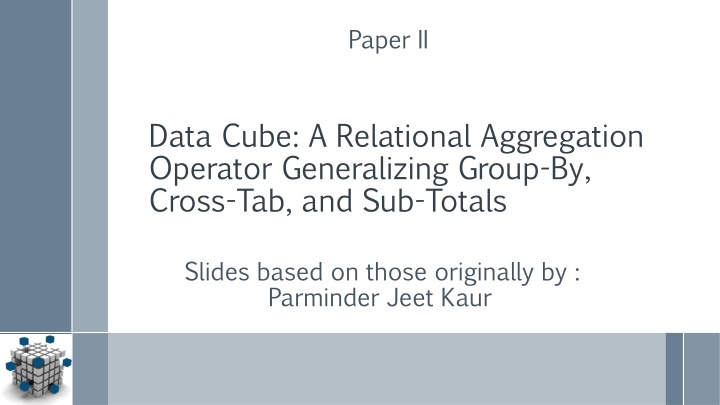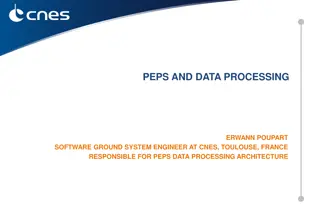
Relational Data Analysis: Understanding Aggregation Operators in SQL
Explore the concept of relational data analysis using aggregation operators in SQL. Learn about GROUP-BY, CUBE, and ROLL-UP operators, and their relevance in N-dimensional data analysis. Discover the challenges and solutions within SQL for summarization tasks like histograms.
Download Presentation

Please find below an Image/Link to download the presentation.
The content on the website is provided AS IS for your information and personal use only. It may not be sold, licensed, or shared on other websites without obtaining consent from the author. If you encounter any issues during the download, it is possible that the publisher has removed the file from their server.
You are allowed to download the files provided on this website for personal or commercial use, subject to the condition that they are used lawfully. All files are the property of their respective owners.
The content on the website is provided AS IS for your information and personal use only. It may not be sold, licensed, or shared on other websites without obtaining consent from the author.
E N D
Presentation Transcript
Paper II Data Cube: A Relational Aggregation Operator Generalizing Group-By, Cross-Tab, and Sub-Totals Slides based on those originally by : Parminder Jeet Kaur
Introduction Data Analysis: What? Why is it useful? How this is done? 1 Standard SQL features & GROUP-BY Operator Relevant features of SQL Problems with Group-By operator 2 CUBE and ROLL-UP Operators General idea of Cube operator Why are they different? 3
Data Analysis Applications look for unusual patterns in data Four steps: Formulating Formulating a complex query Extracting Extracting the aggregated data from DB into a relation Visualizing Visualizing results in N-dimensional space Analyzing Analyzing the results to find unusual or interesting patterns by roll-up and drill-down on data Facilitate decision making
Introduction Data Analysis: What? Why is it useful? How this is done? 1 Standard SQL features & GROUP-BY Operator Relevant features of SQL Problems with Group-By operator 2 CUBE and ROLL-UP Operators General idea of Cube operator Why are they different? 3
Relevant features of SQL Relational system models N-dimensional data as a relation with N-attribute domains Example: 4D Earth temperature data
continued Relevant features of SQL For summarization, standard SQL supports group-by op GROUP-BY operator Partitions the relation into disjoint tuple set Then, aggregates over each sets
Problems with GROUP-BY operator 1. Histograms (i.e., creating buckets) Not allowed! -Weather table, group time into days, weeks or months and group locations into areas (US, Canada) by mapping longitude and latitude to country s name - Standard SQL requires computing of histograms indirectly from a table expression. Much more complicated:
Problems with GROUP-BY operator 2. Roll-up Totals and Sub-Totals for drill-downs. Let s start by looking a bit more at aggregation One dimensional Aggregation SELECT Models, SUM(Sales) SELECT Models, SUM(Sales) FROM Sales FROM Sales GROUP BY Models Models Models Chevy Ford Sales Sales 290 220 GROUP BY Models Year Year Color Color Sales Sales Two dimensional Aggregation SELECT SELECT Years Years, Color, SUM(Sales) , Color, SUM(Sales) FROM FROM Sales Sales GROUP BY Year, Color GROUP BY Year, Color 1994 Black 50 1995 Black 85 1994 White 40 1995 White 115
Problems with GROUP-BY operator 2. Roll-up Totals and Sub-Totals for drill-downs Three dimensional aggregation (by Model by Year by Color) Not relational (can t form a key)
Problems with GROUP-BY operator 2. Roll-up Totals and Sub-Totals for drill-downs Alternate representation 3D aggregation (Pivot table) Creates columns based on subsets of column values rather than subsets of column name (as recommended by Chris Date approach) Results in larger set If one pivots on two columns containing N and M values, the resulting pivot table has N x M values, that s, so many columns and such obtuse column names!
ALL value approach Rather than extending result table by adding new cols Prevents the exponential growth of columns ALL added to fill in the super-aggregation items
ALL value approach - SQL statement to build 3D roll- up - Aggregating over N dimensions requires N unions
Discussion The authors state "Veteran SQL implementers will be terrified of the ALL value --- like NULL, it will create many special cases." What are some of the special cases that you can imagine are created by NULL? What cases can you imagine being created by ALL? Do think ALL is a bigger or a lesser concern than NULL?
Problems with GROUP-BY operator 3. Cross Tabulations Expressing cross-tab queries with conventional SQL is daunting 6D cross-tab requires 64-way union of 64 different GROUP BY operators! Resulting representation is too complex for optimization
Data Cube A data cube is a k-dimensional object containing both fact data and dimensions. Cust3 Customers Cust2 Store5 Store4 Cust1 Store3 Store2 Store1 Item4Item3Item2 Item1 Items A cube contains pre-calculated, aggregated, summary information to yield fast queries.
Lets look a bit at why there are this many group by expressions {S, T, C} {S, T} {S, C} {T, C} C {S} {T} {C} T {} S
Discussion How many applications can you imagine using Data Cubes? What kinds of applications can you think of?
Introduction Data Analysis: What? Why is it useful? How this is done? 1 Standard SQL features & GROUP-BY Operator Relevant features of SQL Problems with Group-By operator 2 CUBE and ROLL-UP Operators General idea of Cube operator Why are they different? 3
CUBE operator N dimensional generalization of simple aggregate function N-1 lower-dimensional aggregates points, lines, planes, cubes Data cube operator builds a table containing all these aggregated values Unifies several common and popular concepts: such as aggregates, group by, histograms, roll-ups and drill- downs and, cross tabs
CUBE operator SELECT Model, Year, Color, SUM (Sales) AS sales FROM Sales WHERE Model in ['Ford', 'Chevy'] AND year BETWEEN 1994 AND 1995 GROUP BY CUBE Model, Year, Color A relational operator GROUP BY and ROLL UP are degenerate forms of the operator. Aggregates over all <select list> attributes in GROUP BY clause as in standard GROUP BY It UNIONs in each super-aggregate of global cube substituting ALL for the aggregation columns If there are N attributes in the <select list>, there will be 2N -1 super- aggregate value
Discussion Does the cube operator strike you as a big or a small change to SQL? What about to the mentality of relational databases?

